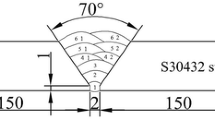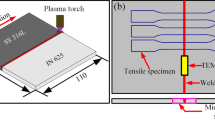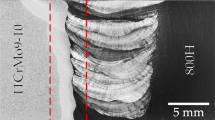Abstract
Characterizations of the microstructure and mechanical property of the fusion boundary region of an Alloy 182-A533B low alloy steel (LAS) dissimilar weld joint were conducted. The existence of type-II boundary that parallels to the fusion boundary in the dilution zone (DZ) of Alloy 182 within a distance of about 50 μm was observed. The chemical composition transition was found in the narrow zone between the type-II and the fusion boundaries. Highest hardness was also found in this narrow zone in the fusion boundary region, implying a high residual strain level in the narrow zone. Lath martensite was observed in both sides of the type-II boundary in DZ, suggesting the localized enrichment of Fe and C adjacent to the type-II boundary due to the diffusion from LAS to DZ. Massive precipitations of carbides were observed on the type-II boundary but not on the fusion boundary. In addition, the orientation relationship at the fusion boundary between the lath martensite in the heat-affected zone in LAS and the austenite in the DZ was found to be Bain, K–S and N–W relationships.











Similar content being viewed by others
References
Sireesha M, Albert SK, Shankar V, Sundaresan S (2000) J Nucl Mater 279:65
USNRC In: Information Notice 2000-17, 18 October 2000
USNRC In: Information Notice 2002-11, 12 March 2002
Peng QJ, Shoji T, Yamauchi H, Takeda Y (2007) Corros Sci 49:2767
Sakai T, Asami K, Katsumata M, Takada H, Tanaka O (1982) In: 1st international conference on current solutions to hydrogen problems in steels, Washington DC, pp 340–348
Matsuda F, Nakagawa H (1984) Trans JWRI 13:159
Ohnishi K, Fuji A, Chiba R, Adachi T, Naitoh K, Okada H (1984) Trans Jpn Weld Soc 15:129
Kinoshita K, Itoh H, Ebata A, Hattori T (1985) Trans Iron Steel Inst Jpn 25:505
Morishige N, Kume R, Okabayashi H (1985) Trans Jpn Weld Soc 16:12
Wu Y, Patchett BM (1992) In: 31st metallurgist conference of CIM Edmonton, Canada
Nelson TW, Lippold JC, Mills MJ (1998) Sci Technol Weld Join 3:249
Nelson TW, Lippold JC, Mills MJ (1999) Weld J 78:329S
Nelson TW, Lippold JC, Mills MJ (2000) Weld J 79:267S
Lee HT, Jeng SL, Yen CH, Kuo TY (2004) J Nucl Mater 335:59
Kim JW, Lee K, Kim JS, Byun TS (2009) J Nucl Mater 384:212
Peng Q, Shoji T, Ritter S, Seifert H (2005) In: 12th international conference on environmental degradation of materials in nuclear power systems—water reactors, TMS, pp 589–599
Celik A, Alsaran A (1999) Mater Charact 43:311
Gourgues AF, Flower HM, Lindley TC (2000) Mater Sci Technol 16:26
Morito S, Tanaka H, Konishi R, Furuhara T, Maki T (2003) Acta Mater 51:1789
Chilton JM, Barton CJ, Speich GR (1970) J Iron Steel Inst 208:184
Krauss G, Marder AR (1971) Metall Trans 2:2343
Maki T, Tsuzaki K, Tamura I (1980) Trans Iron Steel Inst Jpn 20:207
Morito S, Yoshida H, Maki T, Huang X (2006) Mater Sci Eng A 438:237
Pan C, Zhang Z (1996) Mater Charact 36:5
Morito S, Huang X, Furuhara T, Maki T, Hansen N (2006) Acta Mater 54:5323
Acknowledgements
This study was supported by a program on “Mechanism of SCC in the Fusion Boundary Zone of Ni-base weld metal and Low Alloy Steel Dissimilar Weld Joints in High Temperature Oxygenated Water” organized by JSCE and sponsored by Japanese BWR utilities. The authors (J. Hou, J. Q. Wang, E.-H. Han, and W. Ke) would thank the Special Funds for the Major State Basic Research Projects G2006CB605000 in China.
Author information
Authors and Affiliations
Corresponding author
Rights and permissions
About this article
Cite this article
Hou, J., Peng, Q.J., Takeda, Y. et al. Microstructure and mechanical property of the fusion boundary region in an Alloy 182-low alloy steel dissimilar weld joint. J Mater Sci 45, 5332–5338 (2010). https://doi.org/10.1007/s10853-010-4581-6
Received:
Accepted:
Published:
Issue Date:
DOI: https://doi.org/10.1007/s10853-010-4581-6




